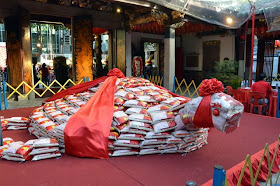By 6pm on that evening, the crowd was already building up by the side of the road, in front of the temple. For many, it is as a tradition and custom to go and pay respects to the Goddess of the Sea, Mazu, and the other resident Gods before looking for a space by the roadside.
The "mee-koo" (bun made into the shape of a tortoise) - which is a symbol of longevity - was laid out as devotees made the offer to the Gods. In the courtyard, there were many sacks of rice, stacked into the shape of the tortoise. Devotees or anyone could seek to bring one back by using the divining blocks to seek permission from the Goddess of the Sea, Mazu.
As the sun set, the lights came on. At 8pm, with the Guest of Honour, the Minister for Manpower, Singapore, joining the crowd, the performance began. Many of the dances were performed by the schools affiliated to the Singapore Hokkien Huay Kuan, which also manages the Thian Hock Keng. On this night, it was a grand event organised by the Singapore Hokkien Huay Kuan, reminiscent of the old days when Thian Hock Keng was the community centre of the immigrant workers and the residents.
Strains of the Nanyin - Southern Sounds - brought back nostalgic memories to the senior citizens as they recalled the days when their elders would be sitting outside the temple, listening to Nan Yin and the songs that talked about the stories of old China. In a way, joss stick fumes, familiar sights of the Gods and Nanyin brought them the peace and comfort of home in China, which they hoped to return after making a decent earning. Many stayed on instead, and the temporary landscape became permanent. For the young, they were as "blur"as to what it is as the tourists and the new non-Chinese citizens who were invited to join in the Cap Go Meh. In a way, it was reminiscent to the old people and an eye opener to the young. Thanks to the dedicated few who carried on playing the Nanyin in Singapore, and put in efforts to train the young, it is making a comeback. If you have yet to watch or listen to Nanyin, come to Thian Hock Keng on 2M19 (23 Mar 11) at 7.30pm to watch Siong Leng Musical Association perform. This date is the celebrations in honour of Guan Yin in Thian Hock Keng.
When the Nanyin troupe strolled up the street, the whole place suddenly came to a standstill. No loudspeakers to blare the music. What could be heard was coaxed out of the musical instruments (that had been used since more than 2000 years ago). Everyone strained their ears.
And when they passed, the whole place was brought back to the present again with the roll of the drums. For the Chinese, noise is important as it is the yang energies that will chase away the yin (negative) energies. And so, on such an joyous occasion, the louder the noise the better. And yet despite the noise the lions pranced their way around. The full concentration of the lone lion jumping over the stilts in a noisy environment was certainly a feat to be admired!
The other show stealer must have been the bald headed tough and young performers from the Nan Shaolin group. They displayed their prowess with the somersault, twist and turn in mid air and defying the hits of the poles. It was gongfu live to the audience.
Time passed by so quickly and all the fun and noise had to come to an end, marking the end of the first 15 days and getting further in the year of the Rabbit, with more festivities to come.
To the hardworking team at Singapore Hokkien Huay Kuan, a great job! I wonder what they are going to outdo themselves again next year. (^^)











